A commensal bacterium - Study guides, Class notes & Summaries
Looking for the best study guides, study notes and summaries about A commensal bacterium? On this page you'll find 141 study documents about A commensal bacterium.
Page 2 out of 141 results
Sort by
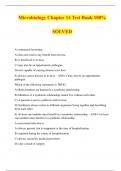
-
Microbiology Chapter 14 Test Bank 100% SOLVED
- Exam (elaborations) • 15 pages • 2023
- Available in package deal
-
- $11.49
- + learn more
Microbiology Chapter 14 Test Bank 100% SOLVED A commensal bacterium A) does not receive any benefit from its host. B) is beneficial to its host. C) may also be an opportunistic pathogen. D) isn't capable of causing disease in its host. E) always causes disease in its host. - ANSmay also be an opportunistic pathogen Which of the following statements is TRUE? A) Both members are harmed in a symbiotic relationship. B) Members of a symbiotic relationship cannot live without each other. ...
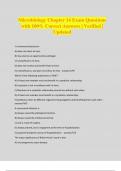
-
Microbiology Chapter 14 Exam Questions with 100% Correct Answers | Verified | Updated
- Exam (elaborations) • 11 pages • 2024
- Available in package deal
-
- $11.49
- + learn more
Microbiology Chapter 14 Exam Questions with 100% Correct Answers | Verified | Updated A commensal bacterium A) does not infect its host. B) may also be an opportunistic pathogen. C) is beneficial to its host. D) does not receive any benefit from its host. E) is beneficial to, and does not infect, its host - answerB Which of the following statements is TRUE? A) At least one member must not benefit in a symbiotic relationship. B) A parasite is not in symbiosis with its host. C) Members...
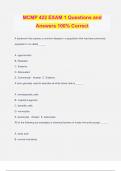
-
MCMP 422 EXAM 1 Questions and Answers 100% Correct
- Exam (elaborations) • 44 pages • 2024
- Available in package deal
-
- $13.49
- + learn more
MCMP 422 EXAM 1 Questions and Answers 100% Correct A bacterium that causes a common disease in a population that has been previously exposed to it is called _____. A. opportunistic B. Resistant C. Endemic D. Attenuated E. Commensal - Answer- C. Endemic A term generally used to describe all white blood cells is _____. A. hematopoietic cells B. myeloid progenitor C. dendritic cells D. monocytes E. leukocytes - Answer- E. leukocytes All of the following are examples of chemical barri...
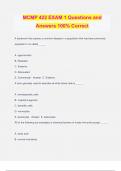
-
MCMP 422 EXAM 1 Questions and Answers 100% Correct
- Exam (elaborations) • 44 pages • 2024
- Available in package deal
-
- $13.49
- + learn more
MCMP 422 EXAM 1 Questions and Answers 100% Correct A bacterium that causes a common disease in a population that has been previously exposed to it is called _____. A. opportunistic B. Resistant C. Endemic D. Attenuated E. Commensal - Answer- C. Endemic A term generally used to describe all white blood cells is _____. A. hematopoietic cells B. myeloid progenitor C. dendritic cells D. monocytes E. leukocytes - Answer- E. leukocytes All of the following are examples of chemical barri...
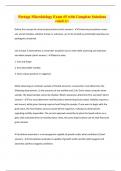
-
Portage Microbiology Exam #5 with Complete Solutions rated A+
- Exam (elaborations) • 9 pages • 2024
-
- $8.99
- + learn more
Define the concept of universal precautions (short answer) - Universal precautions means any and all samples, whether known or unknown, are to be treated as potentially hazardous (or pathogenic) materials List at lease 3 observations a researcher would be sure to note while assessing and unknown microbial sample (short answer) - Need to note: 1. Size and shape 2. Any observable motility 3. Gram status (positive or negative) While observing an unknown sample of limited amounts, a research...

-
Microbiology Chapter 14 Exam Questions with 100% Correct Answers | Verified | Updated
- Exam (elaborations) • 11 pages • 2024
- Available in package deal
-
- $12.49
- + learn more
Microbiology Chapter 14 Exam Questions with 100% Correct Answers | Verified | Updated A commensal bacterium A) does not infect its host. B) may also be an opportunistic pathogen. C) is beneficial to its host. D) does not receive any benefit from its host. E) is beneficial to, and does not infect, its host - answerB Which of the following statements is TRUE? A) At least one member must not benefit in a symbiotic relationship. B) A parasite is not in symbiosis with its host. C) Members...
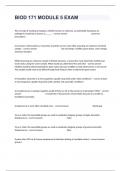
-
BIOD 171 MODULE 5 EXAM Questions And Detailed Answers A+ Score.
- Exam (elaborations) • 7 pages • 2024
- Available in package deal
-
- $12.99
- + learn more
The concept of treating all samples, whether known or unknown, as potentially hazardous (or pathogenic) materials is known as _____. - correct answer universal precautions List at least 3 observations a researcher would be sure to note while assessing an unknown microbial sample. - correct answer size and shape, motility, gram status, color change, chemical reactions While observing an unknown sam...

-
Test Bank for the Human Body in Health & Disease 9th Edition by Patton 2023/2024
- Exam (elaborations) • 442 pages • 2023
-
- $18.99
- + learn more
Test Bank for the Human Body in Health & Disease 9th Edition by Patton d. ammonia to urea for excretion into the urine. ANS: C 61. Ketosis develops in response to a. glycolysis. b. hyperglycemia. c. activation of the urea cycle. d. rapid and incomplete catabolism of fatty acids. ANS: D 62. Which of the following is least related to the aerobic metabolism of glucose? a. Intramitochondrial b. Ketones c. CO 2 + H 2 d. Oxygen ANS: B O + ATP 63. The reaction of –...
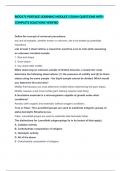
-
BIOD171 PORTAGE LEARNING MODULE 5 EXAM QUESTIONS WITH COMPLETE SOLUTIONS VERIFIED
- Exam (elaborations) • 7 pages • 2024
- Available in package deal
-
- $7.99
- + learn more
BIOD171 PORTAGE LEARNING MODULE 5 EXAM QUESTIONS WITH COMPLETE SOLUTIONS VERIFIED Define the concept of universal precautions. any and all samples, whether known or unknown, are to be treated as potentially hazardous List at least 3 observations a researcher would be sure to note while assessing an unknown microbial sample. 1. Size and shape 2. Gram status 3. Any observable motility While observing an unknown sample of limited amounts, a researcher must determine the following observ...
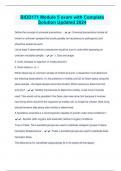
-
BIOD171 Module 5 exam with Complete Solution Updated 2024
- Exam (elaborations) • 6 pages • 2024
-
- $9.39
- + learn more
BIOD171 Module 5 exam with Complete Solution Updated 2024 Define the concept of universal precautions. - ️️ - Universal precautions include all known or unknown samples that could possibly be hazardous (or pathogenic) and should be treated as such. List at least 3 observations a researcher would be sure to note while assessing an unknown microbial sample. - ️️ - 1. Size and shape 2. Color changes to organism or media around it 3. Gram status (+ or -) While observing an unknown s...

Study stress? For sellers on Stuvia, these are actually golden times. KA-CHING! Earn from your study resources too and start uploading now. Discover all about earning on Stuvia


